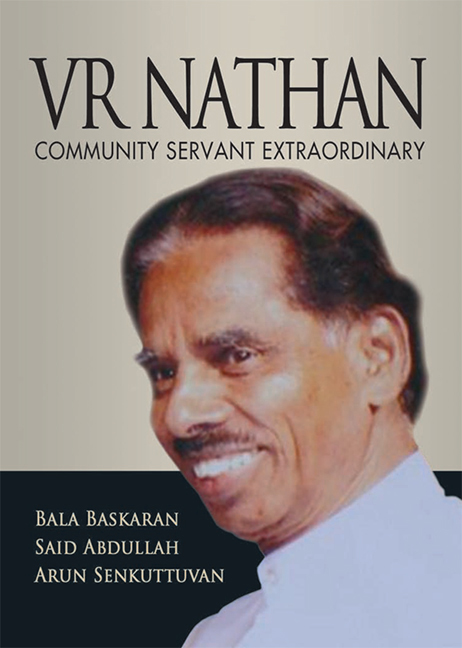Book contents
- Frontmatter
- Contents
- Foreword
- Message
- Preface
- Acknowledgements
- 1 VR's Inter-religious Leadership
- 2 An Immigrant who Made Good
- 3 Introduction to Temple Management Affairs
- 4 Invitation to Help out HEB
- 5 An Era of Change in HEB
- 6 VR's Signal Contribution to HEB's Transformation
- 7 Celebrating Hindu Festivals
- 8 Transforming the Temple Scene
- 9 VR's Views in Public Deliberations of Issues Affecting Indians
- 10 VR's Legacy
- Appendix
- About the Authors
- Plate section
Foreword
Published online by Cambridge University Press: 21 October 2015
- Frontmatter
- Contents
- Foreword
- Message
- Preface
- Acknowledgements
- 1 VR's Inter-religious Leadership
- 2 An Immigrant who Made Good
- 3 Introduction to Temple Management Affairs
- 4 Invitation to Help out HEB
- 5 An Era of Change in HEB
- 6 VR's Signal Contribution to HEB's Transformation
- 7 Celebrating Hindu Festivals
- 8 Transforming the Temple Scene
- 9 VR's Views in Public Deliberations of Issues Affecting Indians
- 10 VR's Legacy
- Appendix
- About the Authors
- Plate section
Summary
The late VR Nathan was an ordinary Hindu Singaporean, who was initially inducted into the Hindu Temple scene only to undertake the specific task of sorting out the financial state of affairs of the Hindu Endowments Board (HEB) that had remained unaudited for five consecutive years. With that task accomplished, he began looking into the operations of HEB and discovered the attendant problems of the HEB; poor management of its four temples and their finances; lack of supervision of the services they provided and the absence of proper controls of expenditures, among others. He came to grips with these weaknesses and discovered the range of problems that needed to be addressed. He began to set them right with hands-on engagement. With the help of HEB's then Secretary – the late P Adistham – VR Nathan overcame the more serious problems needing urgent attention. These and his many other contributions towards the transformations of our temples, his attempts to profile the HEB as more than a temple management organization are well covered in this book by my dear friend Arun Senkuttuvan, such that it requires no further elaboration from me.
He made HEB a more important social orgainsation reflecting the aspirations of the community to be an important element of our multi-racial and religious society.
When VR Nathan came into our temple scene, he was a bank executive, quietly devoted to the practices of his faith. The temple scene was not what it is like today, where our temples are well furbished, operated with decorum and very much on their own, reflecting the respect and appreciation Hindus in our society enjoy in the eyes of those practicing other faiths.
In the past, our temples were dominated by community leaders, whose only claim to leadership had been inherited from their ancestors or by right of their dominance in the South Indian caste practices of the Tamil Nadu. Perhaps the only exception was the Chettiar Temple at Tank Road where traditional practices of management were followed, originating as they were from a temple management culture going back to old times.
VR Nathan worked hard to transform the HEB and the management of its four temples. Through his dedication and management practices, he demonstrated to our Hindu community how our temples could be transformed through proper hands-on management and leadership by example.
- Type
- Chapter
- Information
- VR NathanCommunity Servant Extraordinary, pp. vii - xPublisher: ISEAS–Yusof Ishak InstitutePrint publication year: 2012

